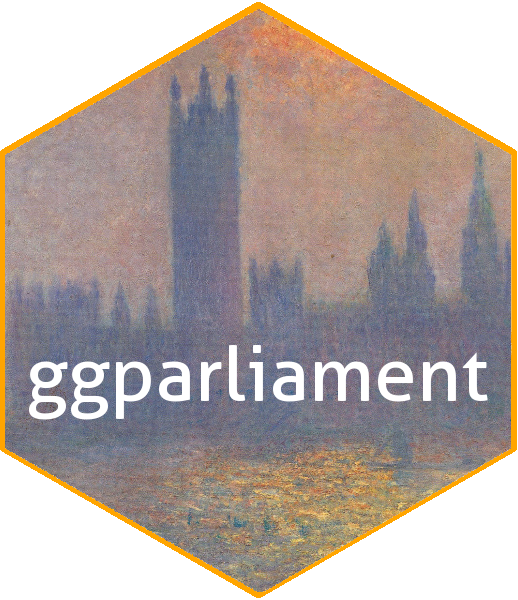RobWHickman / Ggparliament
Programming Languages
Projects that are alternatives of or similar to Ggparliament
title: "README" output: github_document pagetitle: README
Status
ggparliament: Parliament plots
This package attempts to implement "parliament plots" - visual representations of the composition of legislatures that display seats colour-coded by party. The input is a data frame containing one row per party, with columns representing party name/label and number of seats, respectively.
This R package is a ggplot2 extension and is now on CRAN. Please install the stable version in R by running:
install.packages("ggparliament")
To install the package from source:
devtools::install_github("robwhickman/ggparliament")
Inspiration from this package comes from: parliamentdiagram, which is used on Wikipedia, parliament-svg, which is a javascript clone, and a discussion on StackOverflow, which provided some of the code for part for the "arc" representations used in this package.
If you have any issues, please note the problem and inform us!
Election data
ggparliament provides election data from the following countries.
election_data %>%
distinct(year, country, house) %>%
arrange(country, year)
## # A tibble: 39 x 3
## country year house
## <chr> <dbl> <chr>
## 1 Australia 2010 Representatives
## 2 Australia 2010 Senate
## 3 Australia 2013 Representatives
## 4 Australia 2013 Senate
## 5 Australia 2016 Representatives
## 6 Australia 2016 Senate
## 7 Australia 2019 Representatives
## 8 Australia 2019 Senate
## 9 Chile 2009 Diputados
## 10 Chile 2009 Senadores
## # … with 29 more rows
We also provide the following vignettes for further explanation:
- Basic parliament plots
- Labelling parties
- Drawing the majority threshold line
- Highlighting parties in power
- Faceting legislatures
- Emphasizing certain seats
- Visualizaing overhang seats in MMP electoral systems
- Arranging seat order in ggparliament plots.
Quick ggparliament examples can be viewed below.
Semicircle parliament
EU, France, United States, and so on...
Plot of US House of Representatives
#filter the election data for the most recent US House of Representatives
us_house <- election_data %>%
filter(country == "USA" &
year == 2016 &
house == "Representatives")
us_house <- parliament_data(election_data = us_house,
type = "semicircle",
parl_rows = 10,
party_seats = us_house$seats)
us_senate <- election_data %>%
filter(country == "USA" &
year == 2016 &
house == "Senate")
us_senate <- parliament_data(
election_data = us_senate,
type = "semicircle",
parl_rows = 4,
party_seats = us_senate$seats)
representatives <- ggplot(us_house, aes(x, y, colour = party_short)) +
geom_parliament_seats() +
#highlight the party in control of the House with a black line
geom_highlight_government(government == 1) +
#draw majority threshold
draw_majoritythreshold(n = 218, label = TRUE, type = 'semicircle')+
#set theme_ggparliament
theme_ggparliament() +
#other aesthetics
labs(colour = NULL,
title = "United States House of Representatives",
subtitle = "Party that controls the House highlighted.") +
scale_colour_manual(values = us_house$colour,
limits = us_house$party_short)
representatives
Plot of US Senate
senate <- ggplot(us_senate, aes(x, y, colour = party_long)) +
geom_parliament_seats() +
geom_highlight_government(government == 1) +
# add bar showing proportion of seats by party in legislature
geom_parliament_bar(colour = colour, party = party_long) +
theme_ggparliament(legend = FALSE) +
labs(colour = NULL,
title = "United States Senate",
subtitle = "The party that has control of the Senate is encircled in black.") +
scale_colour_manual(values = us_senate$colour,
limits = us_senate$party_long)
senate
Plot of German Bundestag
germany <- election_data %>%
filter(year == 2017 &
country == "Germany")
germany <- parliament_data(election_data = germany,
parl_rows = 10,
type = 'semicircle',
party_seats = germany$seats)
bundestag <- ggplot(germany, aes(x, y, colour = party_short)) +
geom_parliament_seats(size = 3) +
labs(colour="Party") +
theme_ggparliament(legend = TRUE) +
scale_colour_manual(values = germany$colour,
limits = germany$party_short)
bundestag
Opposing Benches Parliament
United Kingdom
#data preparation
uk_17 <- election_data %>%
filter(country == "UK" &
year == "2017") %>%
parliament_data(election_data = .,
party_seats = .$seats,
parl_rows = 12,
type = "opposing_benches",
group = .$government)
commons <- ggplot(uk_17, aes(x, y, colour = party_short)) +
geom_parliament_seats(size = 3) +
theme_ggparliament() +
coord_flip() +
labs(colour = NULL,
title = "UK parliament in 2017") +
scale_colour_manual(values = uk_17$colour,
limits = uk_17$party_short)
commons
Horseshoe parliament
Australia, New Zealand
australia <- election_data %>%
filter(country == "Australia" &
house == "Representatives" &
year == 2016) %>%
parliament_data(election_data = .,
party_seats = .$seats,
parl_rows = 4,
type = "horseshoe")
Plot of Australian parliament
au_rep <-ggplot(australia, aes(x, y, colour = party_short)) +
geom_parliament_seats(size = 3.5) +
geom_highlight_government(government == 1, colour = "pink", size = 4) +
draw_majoritythreshold(n = 76,
label = TRUE,
linesize = 0.5,
type = 'horseshoe') +
theme_ggparliament() +
theme(legend.position = 'bottom') +
labs(colour = NULL,
title = "Australian Parliament",
subtitle = "Government circled in pink.") +
scale_colour_manual(values = australia$colour,
limits = australia$party_short)
au_rep







